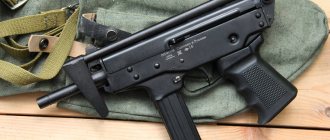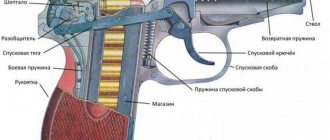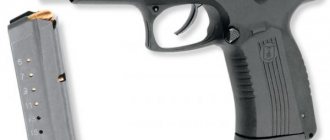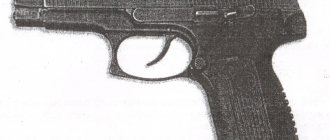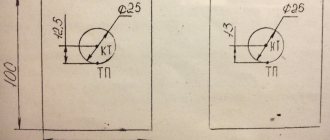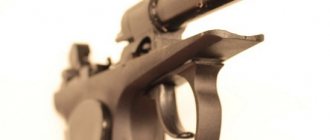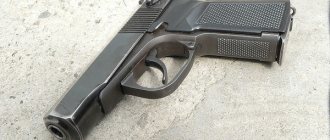History of the Yarygin pistol
In 1990, the USSR Ministry of Defense, based on factual data that the PM (with all its positive characteristics) can no longer meet modern requirements, announced a competition for new weapons. One of the primary goals was to increase the amount of ammunition in the pistol's magazine, and give it the ability to penetrate medium-level body armor. The cartridge should be more powerful (9x19 standard), and 7N21-01 met these requirements. New pistols began to be developed for this warhead.
Three years later, a pistol by small arms designer V.A. was presented at the competition. Yarygina. According to the results of tests that lasted until 2000, Yarygin’s pistol won the competition, among many other competitors. And three years later, this model (with the name MP -443, where the Latin letters indicate the name of the plant) was adopted by the Russian army under the name “9mm Yarygin pistol” (PY). The Izhevsk - Building Plant began to mass-produce this model.
But only in 2010 did the pistol begin to go directly into service, both in the armed forces of the Russian Federation, and in special forces, internal troops and other government agencies. A year later, mass production of these weapons for the Russian army was launched. Since 2012, officers of the Western Military District also began to receive PY on a regular basis.
Different versions of the PL were later developed among them:
- Sports - the frame of the model is made of plastic material, and the magazine is reduced by 10 rounds. The name of the pistol is MP 446S “Viking”.
- The model, which is produced as a commercial model for export, has the same name, but without the letter “C”. It is also made of plastic, but the magazine has a standard volume - 18 rounds. The pistol has an adjustable sight.
- There is a later version of Yarygin’s modified, improved sports pistol “VIKING-M”. The model has an improved barrel life, and the barrel itself is thicker and its length is increased. Many details have been improved: trigger, barrel boss, locking unit, magazine. Manufacturers promise a long total lifespan - 50,000 shots. This model can be offered in several different trim levels.
There are also modifications of PJ in the traumatic version. The MP-353 has been produced since 2010 and is used with the 45 Rubber cartridge. And the MP-472 Vintuk traumatic weapon with a 10x23 T ammunition has a magazine for 16 rounds. A distinctive feature of this model is that the plastic frame is blue.
Since 2008, a gas pneumatic version has also been produced. The manufacturer also currently offers training options (laser) with a red visible laser beam.
Currently, in addition to Russia, PL is used in five more countries:
- in Lithuania - in service with private security structures;
- in Armenia - in the national security service and other law enforcement organizations;
- in Kyrgyzstan - used to reward the military;
- in Kazakhstan - from the beginning of the 2000s it was used as a sporting weapon, but later, since 2007, the pistol has been used as a service weapon for government agencies, legal entities (authorized for official duties);
- in Belarus - pistols were purchased for the Ministry of Internal Affairs for the purpose of training in shooting with this pistol, and improving the skills of employees.
Yarygin’s pistol is exported to any country in the world, but only exclusively (legally) through Rosoboronexport.
Success at work
From the very first days, the novice specialist proved himself to be a skilled inventor and developer of weapons for both military and sporting purposes. In collaboration with colleagues, Vladimir Yarygin developed free and standard self-loading pistols of 5.6 mm caliber, models Izh-34 and Izh-35, for training Olympic-level athletes. Already in 1979, pistols were put into mass production. At international fairs in Brno in 1984 and Plovdiv in 1989, they received gold medals and brought Yarygin wide recognition among the sports community. Using weapons from the Izhevsk designer, shooters from around the world became Olympic champions and won awards at the World and European Championships.
Photo: Kalashnikov Concern
Over the years, Yarygin was involved in the development of such shooting models as the small-sized sports and training self-loading pistol "Margo" for special forces and security services, pistols 6P36, 6P37 commissioned by the Russian army and self-defense pistols Izh-77-8, Izh-77-7.6 , Izh-78-7.6. In addition, the group led by V.A. Yarygin, developed such pistols as MP-448 “Skif”, “Bars”, MP-438 “Olympian” based on Izh-35 for training athletes.
The device of the Yarygin pistol
The design of the Yarygin semi-automatic pistol is based on the recoil principle of a short-stroke barrel. By tilting the barrel in the bolt area, the ammunition is locked in the chamber.
The outer part of the weapon is treated with a special anti-corrosion, protective coating, which gives the right to use this model in regions and countries with a tropical, humid climate. There are corrugations on all significant working parts of the pistol.
The operating principle of the PY is as follows:
- When pressing on the hook, the released trigger hits the firing pin, and it breaks the cartridge capsule.
- The powder charge ignites.
- During the firing process, compressed powder gases affect the barrel and bolt.
- The bullet under pressure is pushed out of the barrel channel, which, thanks to six rifling, gives the bullet direction and rapid acceleration.
- The barrel and bolt move back. After a short stroke, the barrel and bolt are separated, and the bolt continues to move back alone.
- The sleeve, having met the reflector, is eliminated through a special bolt compartment.
- In the final rear position, the bolt returns the trigger to its original location - to combat erection.
- Under the influence of the return spring, the bolt comes to the front zone, while it picks up the next ammunition from the magazine with the rammer and sends it into the chamber.
- The weapon is again prepared for firing when the bolt engages the barrel in the extreme forward position, and the channel is already firmly locked by the bolt.
To fire again, lower the trigger and squeeze it. Firing is carried out until the last ammunition in the magazine is used.
When the last cartridge is expended, the bolt automatically locks, remaining in the rear position.
Advantages and disadvantages of the Grach pistol
Compared to its previous analogue (PM), the Yarygin pistol has a lot of modern improvements and modifications.
Advantages and disadvantages
The pistol has six rifling in the barrel (two more than the PM) - this allows you to significantly increase the muzzle velocity
Large magazine capacity - 18 rounds (10 more than its predecessor)
The bolt is locked by tilting the barrel - a more reliable lock
The use of lightweight steel in the manufacture of pistols
The model is suitable for right-handers and left-handers, since the safety flags are on both sides
The bolt carrier protects the trigger so that it does not cling to clothing or a holster
Push-button mechanism for instant magazine release
Sensitive to changes in ammunition - different domestic factories make different cartridges
The quality of finished pistols is not always of the required level, the same applies to ammunition - this contributes to the rapid breakdown of parts and elements
Possible misfires when shooting from edged weapons
Perceptible weight
The scope often catches on your holster or clothing
When reloading, the edges of magazine sponges can severely injure your fingers (to the point of bleeding)
Consists of a large number of small elements and parts, which increases the risk of breakdowns
There may be delays when firing; the spent cartridge case may get stuck in the chamber
Appearance
In appearance, without any particular quibbles, you can easily recognize the combat weapon "Rook". The silumin body, weight and dimensions delight the owner with their combination. The shutter, as always, is covered with intimidating white inscriptions from the manufacturer. The fuse box, as in the combat version, is presented on both sides.
The handle is plastic and tries to copy the appearance of its older brother. There is also an eyelet for a training jacket. The Gletcher Grach air pistol has retained its original square shape, an experienced hardball player will recognize exclusively our thousandth Anixes.
There's nothing good about the sights here. Yarygin's air pistol has lost the functionality of its transverse rear sight adjustment, and now it has an absolutely dead design. Taking into account the feedback from some owners regarding the inaccuracy of the factory zeroing, it remains to think about such a step by the manufacturer. The rear sight and front sight have white reflective dots, but given the impossibility of adjustment, this is just a drop in the ocean.
Components of the Yarygin pistol
The pistol's configuration includes the following:
- The trigger type PY trigger (open trigger) with self-cocking, frame with trigger guard.
- A fairly capacious box magazine for 18 rounds allows all cartridges to be placed in two rows. Thanks to special recesses, there is a chance to visually control how many cartridges are in the magazine during firing.
- The PY has a double-action safety, which makes the weapon convenient not only for right-handed people, but also for left-handed people. Thanks to the universal button, the magazine can be removed instantly.
- Flag fuse ensures maximum safety. It reliably blocks the trigger and the bolt in the cocked and deflated state.
- The pistol bolt is equipped with a striker.
- The ejector with its protruding zone indicates that there is a warhead in the chamber - this is an additional control (visual).
- The convenient geometry of the guard (safety) and the handle makes it possible to fire shots with one or two hands, even while wearing gloves.
- A well-thought-out sighting design guarantees high-quality shooting at a distance of up to 50 m.
Additional removable fastenings are provided in the form of a Weaver rail, elements for installation on the front zone of the barrel - luminous (for night-time, poor lighting) flashlights for illuminating the target, and optical sights.
Cartridges for PYa
The development of domestic 9x19 cartridges in the early 90s was necessary in order to increase and improve the level of resources of personal weapons intended for self-defense or attack. This standard corresponds to the dimensions of a NATO warhead:
- internal ballistics are completely identical;
- the cartridge is designed for sale in pistols - PYA, GSh-18;
- it is also suitable for submachine guns.
Currently, warheads are divided into two types:
- cartridge, the bullet has a steel core - 9x19 PS (7N21);
- a cartridge with a bullet with increased penetration - 9x19 PBP (7N31).
The PYa has convenient, capacious magazines for ammunition, which can hold 18 rounds of ammunition in two rows.
Disassembling the Yarygin pistol
This weapon can be disassembled in two ways.
Partial disassembly consists of the following steps:
- Remove the magazine by pressing its latch.
- Make sure that there is no cartridge in the chamber - to do this, turn the fuse box down, and, moving the bolt back, inspect the chamber. To return the shutter to its original state, press the contactor flag (down). You can also slightly pull the shutter back and release it to the extreme forward position.
- Make sure to perform a control descent with the pistol lowered down and to the side, in order to avoid injury.
- Remove the cover and separate the contactor from the frame. Holding the weapon by the handle, push the lock from the right zone, followed by removing it from the frame opening.
- Moving forward in the directions of the frame, disconnect the barrel with the bolt from it.
- Remove the barrel and the return spring by separating them - holding them by the edges of the coupling, moving them forward, and at the same time turning the barrel.
- Disconnect the return spring and rod from the barrel.
Complete disassembly is the second method, performed after completing incomplete disassembly. It is produced in the following steps:
- Separate the handle from the frame by pressing on the protruding part of the latch under the magazine in the frame. Slide the handle stopper with a cleaning rod and remove it from the hole. After this, the handle is moved down and back until it is separated from the frame.
- Remove the trigger mechanism. Using a ramrod, press on the axle at the trigger, then push it forward and remove it. With the fingers of one hand, they “stomp” the protrusion of the trigger rod, and with the other hand, holding the trigger, they carefully remove the entire mechanism from the base of the frame, moving it upward.
- The mainspring is shared with the pusher. The trigger is placed in the firing position, and the end of the ramrod (thin part) is inserted into the pusher opening. Fix the spring. Then remove the hammer from cocking and turn it all the way in the reflector. The upper part of the pusher and the lower part are brought out.
- Remove the mainspring from the pusher by holding them and removing the connecting pin from the hole.
- Remove the stopper latch from the handle by pressing the stopper, pushing it out and removing it.
- The trigger is separated from the frame; to do this, use a ramrod to press, push, and remove its axle from the frame.
- The spring and sear are removed from the base of the frame by removing the axis of the latter, and by turning it at a right angle, followed by smooth removal. Then remove the spring from the sear socket.
- The fuse is separated by pressing its latch (moving it forward), removing the flag from the guides, and slowly removing it from the frame.
- The front part of the reflector is slightly rotated, while the rear part is removed from the frame, towards the front.
- I separate the latch from the magazine - by pressing on the latch, the latch stopper is pressed out, which will allow you to remove the latch.
- They disassemble the magazine latch - take out the spring and the latch, disconnect them.
- Disassemble the trigger mechanism - by extending the rod axis, disconnect the rod from the spring and hook.
- The spring and the firing pin are taken out of the bolt; to do this, press the protrusion of the firing pin (all the way), pull out the bar, and remove the parts, separating them from each other.
- Separate the ejector from the oppressor.
- They disassemble the magazine - press on the protrusion of the spring, and take out the cover, take out the feeder and the spring, and then separate them from each other.
This completes the complete disassembly of the PYa. The weapon is assembled in the reverse order and in strict order. After assembly is completed, the gun must be checked in operation. All elements and parts must be firmly and securely assembled, there should be no distortions or inconsistencies.
Functional
Let's start with the mechanics. The trigger mechanism is double action, you can shoot with or without pre-cocking the hammer. As with any glacier, the Gletcher Grach air pistol is equipped with a fully functional slide stop, safety, and magazine release button, similar to its combat counterpart. There is also an incomplete disassembly, although it differs from the original:
In the same version, disassembly occurs in the following order:
- Removing the magazine
- Removing the slide stop (press the button on the back side)
- We remove the safety, cock the hammer, remove the bolt (using the method towards you and upwards)
- Removing the return spring
When you take it apart, the store catches your eye. The Gletcher Grach air pistol, unlike other domestically produced analogues, has a full-size magazine with a built-in valve. To pierce the balloon, a clamping screw is used, hidden behind a plastic cover.
The declared shot speed is 115 m/s. Many owners write off the average 100 capes. The accuracy is mentioned above - in the absence of adjustable devices it’s not worth talking about, the accuracy is average - it’s enough to destroy bottles and big hardball players in defense.
Obtaining a weapons permit
In Russia, you can obtain a firearms permit if you have a hunting license (for a hunter), or for sport shooting (for athletes). The rest of the citizens of our country are prohibited from purchasing and owning short-barreled military weapons according to the law of the Russian Federation.
For self-defense, you can use traumatic models of pistols by obtaining a license and permission to carry, use and store these weapons in advance. To do this you need:
- attend (self-paid) training courses in handling a specific pistol, followed by passing an exam in theory and practice;
- issue a certificate (of the required sample) by passing a medical examination at the clinic (paid for independently);
- pay the state fee and present the receipt when applying for a permit at the police station;
- prepare a photo size 3x4 (2 pcs.), and a copy of your passport;
- buy an appropriate (metal) safe with reliable locks where the pistol and ammunition will be stored (in a compartment isolated from the weapon and locked);
- Having collected all the above documents, come to the police department (LRO department) at your place of residence with an application for a permit.
Upon receipt of the necessary document (the license is issued in two weeks), you should monitor the validity period (for five years). Three months before the expiration of the license, it is necessary to contact the police in advance for a timely renewal of its validity. For an expired license, the law of the Russian Federation establishes a fine.
You should know that for violations of the required storage conditions of an LLC, the owner, according to the law, faces a fine of up to 2,000 rubles. or license revocation for up to two years. The owner of the weapon may even face imprisonment if, through his fault (due to improper storage of the pistol), an accident occurs that results in the death of a person.
Citizens under 21 years of age will be denied a special permit to use LLC in Russia, according to the law of the Russian Federation.
Notes
- ↑
- (unavailable link). Retrieved July 11, 2013.
- ↑ Galina Valeeva. Once again about Yarygin’s pistol. // “Kalashnikov. Weapons, ammunition, equipment", No. 1, 2013. pp.52-54
- ://www.lasertools.ru/products/trainer/weapon.html
- ↑
- « PYa pistol of 9 mm caliber - 15 pcs.
»Resolution of the Ministry of Internal Affairs of the Republic of Belarus No. 223 of July 16, 2015 - “ Registration number: 2.2.1/002 Sports training pistol MP 446 VIKING
” Resolution of the Government of the Republic of Kazakhstan No. 1367 of December 25, 2002 “On approval of the State Cadastre of civilian and service weapons and ammunition for them” - " Registration number: 3.1/017 Service pistol MP 443 GRACH
" Resolution of the Government of the Republic of Kazakhstan No. 1305 of December 28, 2006 "On approval of the State Cadastre of civilian and service weapons and ammunition for them for 2007" - Fedor Maksimov, Kabai Karabekov. The Kyrgyz authorities sold award weapons to three hundred Russians, including the person under investigation // Kommersant newspaper, No. 17 of February 1, 2012. p. 1
- Decree of the Government of the Russian Federation No. 166 of March 21, 2003
- Decree of the Government of the Russian Federation No. 718 of December 5, 2005 “On awarding weapons to citizens of the Russian Federation”
- Decree of the Government of the Russian Federation No. 568 of September 16, 2006
- . Kommersant (October 9, 2008). Retrieved August 14, 2010.
- Decree of the Government of the Russian Federation No. 776 of October 2, 2009 “On the provision of combat hand-held small arms and other weapons, ammunition for them, special means, equipment and equipment for the federal bailiff service”
